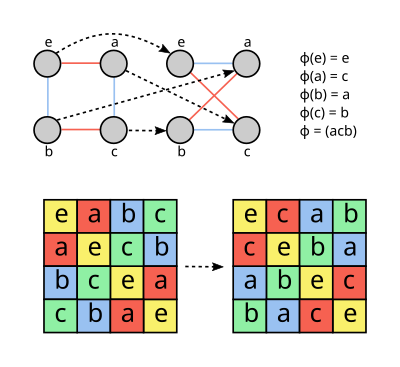Inmathematics, an automorphism is an isomorphism from a mathematical object to itself. It is, in some sense, a symmetry of the object, and a way of mapping the object to itself while preserving all of its structure. The set of all automorphisms of an object forms a group, called the automorphism group. It is, loosely speaking, the symmetry group of the object.

In an algebraic structure such as a group, a ring, or vector space, an automorphism is simply a bijective homomorphism of an object into itself. (The definition of a homomorphism depends on the type of algebraic structure; see, for example, group homomorphism, ring homomorphism, and linear operator.)
More generally, for an object in some category, an automorphism is a morphism of the object to itself that has an inverse morphism; that is, a morphism is an automorphism if there is a morphism such that where is the identity morphismofX. For algebraic structures, the two definitions are equivalent; in this case, the identity morphism is simply the identity function, and is often called the trivial automorphism
The automorphisms of an object X form a group under compositionofmorphisms, which is called the automorphism groupofX. This results straightforwardly from the definition of a category.
The automorphism group of an object X in a category C is often denoted AutC(X), or simply Aut(X) if the category is clear from context.
One of the earliest group automorphisms (automorphism of a group, not simply a group of automorphisms of points) was given by the Irish mathematician William Rowan Hamilton in 1856, in his icosian calculus, where he discovered an order two automorphism,[5] writing:
so that is a new fifth root of unity, connected with the former fifth root by relations of perfect reciprocity.
In some categories—notably groups, rings, and Lie algebras—it is possible to separate automorphisms into two types, called "inner" and "outer" automorphisms.
In the case of groups, the inner automorphisms are the conjugations by the elements of the group itself. For each element a of a group G, conjugation by a is the operation φa : G → G given by φa(g) = aga−1 (ora−1ga; usage varies). One can easily check that conjugation by a is a group automorphism. The inner automorphisms form a normal subgroup of Aut(G), denoted by Inn(G); this is called Goursat's lemma.
The other automorphisms are called outer automorphisms. The quotient group Aut(G) / Inn(G) is usually denoted by Out(G); the non-trivial elements are the cosets that contain the outer automorphisms.
The same definition holds in any unital ringoralgebra where a is any invertible element. For Lie algebras the definition is slightly different.